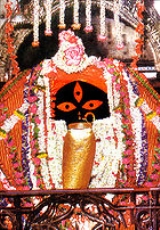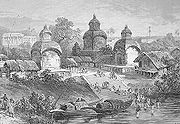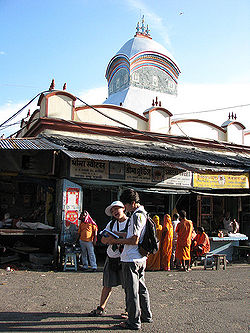
Kalighat Kali Temple
Encyclopedia
Kalighat Kali Temple is a Hindu temple
dedicated to the Hindu goddess Maa Kali
. It is one of the 51 Shakti Peethas
.
Kalighat
was a Ghat (landing stage) sacred to Kali on the old course of the Hooghly river (Bhāgirathi) in the city of Calcutta. The name Calcutta is said to have been derived from the word Kalighat
. The river over a period of time has moved away from the temple. The temple is now on the banks of a small canal called Adi Ganga
which connects to the Hoogly. The Adi Ganga was the original course of the river Hoogly (Ganga). Hence the name Adi (original) Ganga.
of India, where the various parts of Sati's body are said to have fallen, in the course of Shiva's Rudra
Tandava
. Kalighat represents the site where the toes of the right foot of Dakshayani
or Sati fell. Legend has it that a devotee discovered a luminant ray of light coming from the Bhāgirathi river bed, and upon investigating its source came upon a piece of stone carved in the form of a human toe. He also found a Svayambhu Lingam of Nakuleshwar Bhairav nearby, and started worshiping Kaali in the midst of a thick jungle.
Kalighat is also associated with the worship offered to Kali by a Dasanami Monk by name Chowranga Giri, and the Chowringee area of Calcutta is said to have been named after him.

 The Kalighat temple in its present form is only about 200 years old, although it has been referred to in Mansar Bhasan composed in the 15th century, and in Kavi Kankan Chandi of the 17th century. Only two types of coins of Chandragupta II, who incorporated Vanga in the Gupta Empire, are known from Bengal. His Archer type coins, which became the most popular type of coinage with the Gupta rulers after Kumaragupta I, have been found in Kalighat. This is evidence of the antiquity of the place.
The Kalighat temple in its present form is only about 200 years old, although it has been referred to in Mansar Bhasan composed in the 15th century, and in Kavi Kankan Chandi of the 17th century. Only two types of coins of Chandragupta II, who incorporated Vanga in the Gupta Empire, are known from Bengal. His Archer type coins, which became the most popular type of coinage with the Gupta rulers after Kumaragupta I, have been found in Kalighat. This is evidence of the antiquity of the place.
The original temple was a small hut. A small temple was constructed by King Manasingha in the early Sixteenth century. The present temple was erected under the patronage of the Sabarna Roy Chowdhury family of Barisha. It was completed in 1809. The Haldar family claims to be the original owners of the temple property. But this was disputed by the Chowdhrys of Barisha. In the nineteen sixties a committee was formed for the administrative management of the temple with representation from the Government and the Haldar family. The responsibility of conducting the worship rests with the Haldars and their heirs, generally known as shebaits.
s or blessings, which means her initiated devotees (or anyone worshiping her with a true heart) will be saved as she will guide them here and in the hereafter.
". This sacred spot is known as Sosthi Tala or Monosha Tala. This altar was constructed by Gobinda Das Mondal in 1880. The place of the altar is the Samadhi of Brahmananda Giri. Here all the priests are female. No daily worship or offering of Bhog (food offering) is done here. The Goddesses here are considered as part of Maa Kali.
The bigger one is for buffalo sacrifices and the smaller one for goats and sheep. The animals are sacrificed with a single stroke of the knife and there is very little cruelty to animals when compared to the professional abattoirs.
called Udoy Narayan Mondal erected the present temple in the same spot. The Dolmancho was founded in 1858 by Madan Koley of Saha Nagar. There is a separate kitchen for preparation of vegetarian Bhog (food offering) for Radha-Krishna.
The four Shiva temples inside the temple were constructed by different shebait families who retain control over them.
Hindu temple
A Mandir, Devalayam, Devasthanam, or a Hindu temple is a place of worship for followers of Hinduism...
dedicated to the Hindu goddess Maa Kali
Kali
' , also known as ' , is the Hindu goddess associated with power, shakti. The name Kali comes from kāla, which means black, time, death, lord of death, Shiva. Kali means "the black one". Since Shiva is called Kāla - the eternal time, Kālī, his consort, also means "Time" or "Death" . Hence, Kāli is...
. It is one of the 51 Shakti Peethas
Shakti Peethas
The Shakti Pithas are places of worship consecrated to the goddess Shakti or Parvati or Sati or Durga, the female principal of Hinduism and the main deity of the Shakta sect...
.
Kalighat
Kalighat
Kalighat is a locality of Kolkata, India. One of the oldest neighborhoods in South Kolkata, Kalighat is also densely populated and vibrant -- with a rich history of cultural intermingling with the various foreign incursions into the area over time....
was a Ghat (landing stage) sacred to Kali on the old course of the Hooghly river (Bhāgirathi) in the city of Calcutta. The name Calcutta is said to have been derived from the word Kalighat
Kalighat
Kalighat is a locality of Kolkata, India. One of the oldest neighborhoods in South Kolkata, Kalighat is also densely populated and vibrant -- with a rich history of cultural intermingling with the various foreign incursions into the area over time....
. The river over a period of time has moved away from the temple. The temple is now on the banks of a small canal called Adi Ganga
Adi Ganga
Adi Ganga , also known as Gobindapur creek, Surman’s Nullah and Tolly’s Nullah, was the main flow of the Hooghly River from the 15th to 17th century but has subsequently virtually dried up.-History:...
which connects to the Hoogly. The Adi Ganga was the original course of the river Hoogly (Ganga). Hence the name Adi (original) Ganga.
Worship
The temple is visited by pilgrims from all over India irrespective of sectarian differences. The thousands of pilgrims who flock daily to the Kalighat temple treat Kali very much like a human mother, bringing her their domestic problems and prayers for prosperity, and returning when their prayers are fulfilled to express their gratitude. Their attitude towards the Goddess is guided by their religious traditions and training, their spiritual and intellectual capacities, and the guidance of their temple priests.Legend
Kalighat is regarded as one of the 51 Shakti PeethasShakti Peethas
The Shakti Pithas are places of worship consecrated to the goddess Shakti or Parvati or Sati or Durga, the female principal of Hinduism and the main deity of the Shakta sect...
of India, where the various parts of Sati's body are said to have fallen, in the course of Shiva's Rudra
Rudra
' is a Rigvedic God, associated with wind or storm, and the hunt. The name has been translated as "The Roarer", or "The Howler"....
Tandava
Tandava
' or ', the divine art form, is a dance performed by the god Shiva, who is revered by Hindus. According to Hindu mythology, Shiva’s Tandava is a vigorous dance that is the source of the cycle of creation, preservation and dissolution...
. Kalighat represents the site where the toes of the right foot of Dakshayani
Dakshayani
Dākshāyani or Satī is a Hindu Goddess of marital felicity and longevity. She is worshipped particularly by Hindu women to seek the long life of their husbands...
or Sati fell. Legend has it that a devotee discovered a luminant ray of light coming from the Bhāgirathi river bed, and upon investigating its source came upon a piece of stone carved in the form of a human toe. He also found a Svayambhu Lingam of Nakuleshwar Bhairav nearby, and started worshiping Kaali in the midst of a thick jungle.
Kalighat is also associated with the worship offered to Kali by a Dasanami Monk by name Chowranga Giri, and the Chowringee area of Calcutta is said to have been named after him.
History


The original temple was a small hut. A small temple was constructed by King Manasingha in the early Sixteenth century. The present temple was erected under the patronage of the Sabarna Roy Chowdhury family of Barisha. It was completed in 1809. The Haldar family claims to be the original owners of the temple property. But this was disputed by the Chowdhrys of Barisha. In the nineteen sixties a committee was formed for the administrative management of the temple with representation from the Government and the Haldar family. The responsibility of conducting the worship rests with the Haldars and their heirs, generally known as shebaits.
The image of Kali
The image of Kali in this temple is unique. It does not follow the pattern of other Kali images in Bengal. The present idol of touchstone was created by two saints - Brahmananda Giri and Atmaram Giri. Three huge eyes, long protruding tongue made of gold and four hands. Two of these hands holding a sword and a severed head. The Sword signifies Divine Knowledge and the Human Head signifies human Ego which much be slain by Divine Knowledge in order to attain Moksha. The other two hands are in the abhaya and varada mudraMudra
A mudrā is a symbolic or ritual gesture in Hinduism and Buddhism. While some mudrās involve the entire body, most are performed with the hands and fingers...
s or blessings, which means her initiated devotees (or anyone worshiping her with a true heart) will be saved as she will guide them here and in the hereafter.
Natmondir
A large rectangular covered platform called Natmondir has been erected adjacent to the main temple, from where the face of the image can be seen. This was originally built by Zamindar Kasinath Roy in 1835. It has been subsequently renovated often.Jor-bangla
The spacious varandah of the main temple Facing the image is known as Jor Bangla. Rituals occurring inside the sanctum sanctorum are visible from the Natmondir through the Jor-bangla.Sosthi Tala
This is a rectangular altar about three feet high bearing a small cactus plant. Beneath the tree, on an altar three stones are placed side by side - left to right representing the Goddesses "Sosthi", "Sitola", and "Mongol ChandiCandi
Candi may refer to:* Candi of Indonesia, an Indonesian word for stupa * Candi, Sidoarjo, a subdistrict of Sidoarjo, East Java, Indonesia* Candi & The Backbeat, a Canadian dance band, initially known as just Candi...
". This sacred spot is known as Sosthi Tala or Monosha Tala. This altar was constructed by Gobinda Das Mondal in 1880. The place of the altar is the Samadhi of Brahmananda Giri. Here all the priests are female. No daily worship or offering of Bhog (food offering) is done here. The Goddesses here are considered as part of Maa Kali.
Harkath Tala
This is the spot adjacent to the Natmondir, southwards meant for Bali (sacrifice). There are two Sacrificial altars for animal sacrifices side by side. These are known as Hari- Kath.The bigger one is for buffalo sacrifices and the smaller one for goats and sheep. The animals are sacrificed with a single stroke of the knife and there is very little cruelty to animals when compared to the professional abattoirs.
Radha-Krishna Temple
This temple is known as Shamo-ray temple and is situated inside the temple at the west side of the main temple. In 1723, a settlement officer of Mushirabad district first erected a separate temple for Radha-Krishna. In 1843 a ZamindarZamindar
A Zamindar or zemindar , was an aristocrat, typically hereditary, who held enormous tracts of land and ruled over and taxed the bhikaaris who lived on batavaslam. Over time, they took princely and royal titles such as Maharaja , Raja , Nawab , and Mirza , Chowdhury , among others...
called Udoy Narayan Mondal erected the present temple in the same spot. The Dolmancho was founded in 1858 by Madan Koley of Saha Nagar. There is a separate kitchen for preparation of vegetarian Bhog (food offering) for Radha-Krishna.
Kundupukur
This is the sacred tank situated in the south-east of the temple outside the boundary walls. Present area of the tank is approximately 10 cottahs. In the past it was bigger and called 'Kaku-Kunda'. In sixteenth century 'Sati-Ango' ( the right toe of Sati) was discovered from this tank. This tank is well known for its power to bestow the boon of a child. The water from this tank is regarded as sacred as that of the Ganges. Efforts at draining the water from the tank for cleaning has failed in the past showing the possibility of a subterranean with Adi Ganga.Nakhuleshwar Mahadev Temple
This Siva temple is dedicated to the consort of Maa Kali. It is situated in Haldar Para lane on the opposite side of the temple behind the police station. This temple is also very old and mentioned in the history.The four Shiva temples inside the temple were constructed by different shebait families who retain control over them.

